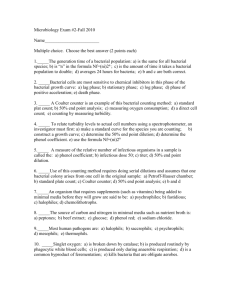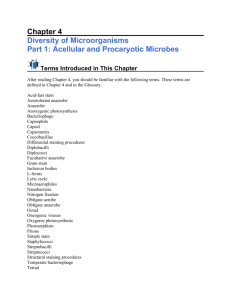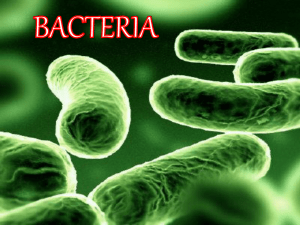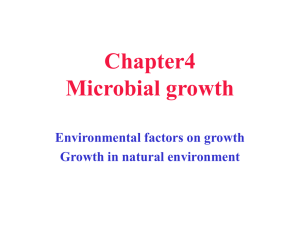PowerPoint
advertisement
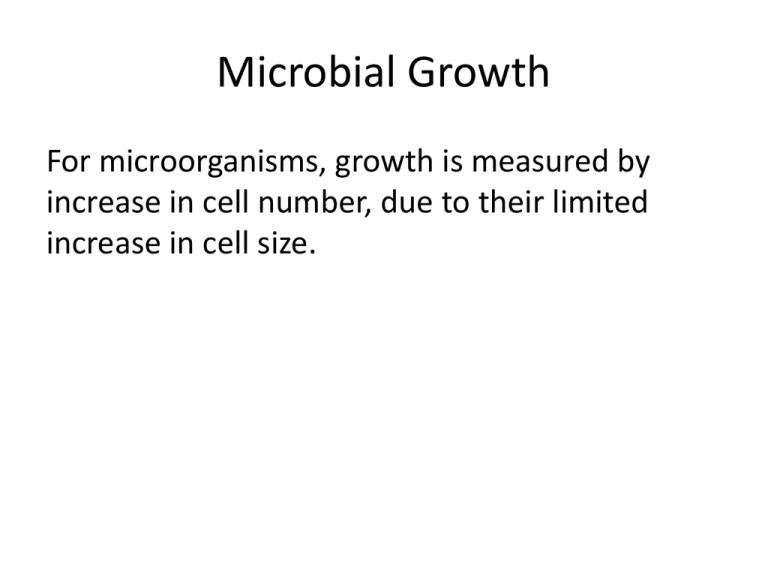
Microbial Growth For microorganisms, growth is measured by increase in cell number, due to their limited increase in cell size. Bacteria are classified by: • • • • Temperature Range pH Range Osmotic Pressure Need for Oxygen Other Classifications • Facultative: Microorganisms that can grow in more than one environment • Obligate: Microorganisms that have specific environments strictly needed for growth Temperature Range • Psychrophile: 0-30 degrees C range, 15 C optimum growth temperature • Mesophile: 25-40 degrees C range, 37 C optimum growth temperature. These have most pathogens, optimized for body temperature. • Thermophile: 40-110 degrees C range, 55 C optimum growth temperature. pH Range • Acidophiles: Grow in acidic environment, pH less than 6.5. Linked to stomach ulcers. • Neutrophiles: Grow in neutral environment, pH 6.5-7.5. Most pathogens are neutrophiles, as your body is mostly within this pH range. • Alkaliphiles: Grow in basic environments, pH greater than 7.5. pH • PH a factor in food spoilage: Canned food high in botulism • Acid rain effect the environment • Bacteria often produce acids that eventually interfere w/ their own growth. Osmotic Pressure Range • Low osmotic pressure kills many prokaryotes. • Halophiles: microbes that can survive in salty environments. • Obligate Halophiles: microbes that need salty environments to survive. Nutritional Requirements for Growth • Carbon: All living things need a carbon source • Nitrogen: used in protein and nucleic acid synthesis • Sulfur: used in protein synthesis • Phosphorus: Used in ATP and nucleic acids • Trace Elements: (Fe, Zn, Cu, etc.) Co-factors and co-enzymes to activate enzymes. Nutritional Requirements Cont. • Trace Elements: (Fe, Zn, Cu, etc.) Co-factors and co-enzymes to activate enzymes. Only in small amounts. • Organic Growth Factors are organic compounds that are essential to the organism but the organism is unable to synthesize it itself (ex. Vitamins, amino acids, nucleotides). Classifications for Oxygen Need • Obligate Aerobes: Must have free oxygen for aerobic respiraiton. • Obligate Anaerobes: Killed by free oxygen. Growth only occurs where there is no oxygen. Oxygen Needs Cont. • Facultative Anaerobes: Have both aerobic and anaerobic growth. Growth is greater in the presence of oxygen because full respiration occurs. • Aerotolerant anaerobes: Only anaerobic growth, but can tolerate the presence of oxygen. Growth occurs evenly throughout media as oxygen has no effect. Oxygen Needs Cont. • Microaerophiles: Only aerobic growth. Oxygen is required in low concentrations. Growth occurs only where a low concentration of oxygen has diffused into the medium. Bacteria classified according to their Oxygen needs • Obligate aerobes – Must have free oxygen for aerobic respiration – Grow only occurs on top of media where there is high concentration of oxygen Bacteria classified according to their Oxygen needs • Falcutative Anaerobes – Both aerobic and anaerobic growth – Growth is greater in the presence of oxygen . – Growth occurs throughout media. Bacteria classified according to their Oxygen needs • Obligate anaerobes – killed by free oxygen – Growth occurs only where there is no oxygen Bacteria classified according to their Oxygen needs • Aerotolerant Anaerobes – Only anaerobic growth; but can tolerate the presence of oxygen – Growth occurs evenly throughout media as oxygen has no effect Bacteria classified according to their Oxygen needs • Microaerophiles – Only aerobic growth – oxygen is required in low concentrations. – Growth occurs only where a low concentration of oxygen has diffused into medium Culture, Colony and Culture Media • Culture: The actual bacteria being grown. • Colony: A group of the same bacteria growing together. • Culture Media: What the bacteria are growing on or in. Culture Media Two types of culture media • Broth: A liquid nutrient media without agar • Agar: a common solidifying agent for a culture medium. Agar • It is added to nutrient medium to solidify it in order to bacterial grow colonies. • It is made form seaweed. It has long been used in various foods from jellies, soups, and ice cream. • Few microbes can break down agar. • Different freezing/melting points. Solid to liquid at 94 C, liquid to solid at 42 C. Labs keep it liquid at 50 C Culture Media Cont. • Chemically Defined: Medium in which the exact chemical composition is known. Often used to grow fastidious organisms. Expensive to buy. • Complex: Used to grow most of the common bacteria and fungi that would be used in an introductory lab. Made of nutrients such as extracts from yeast, meat and plants. • Anaerobic Growth Media/Reducing Media: No free oxygen and used to grown obligate anaerobes. Culture Media Cont. • Selective: Media that is designed to suppress the growth of unwanted bacteria and encourage the growth of wanted bacteria. • Differential: Makes it easier to distinguish colonies of the desired organism from other colonies growing on the same plate. • Enrichment: Used to encourage the growth of a particular organism in a mixed culture. Example soil, fecal samples etc...




